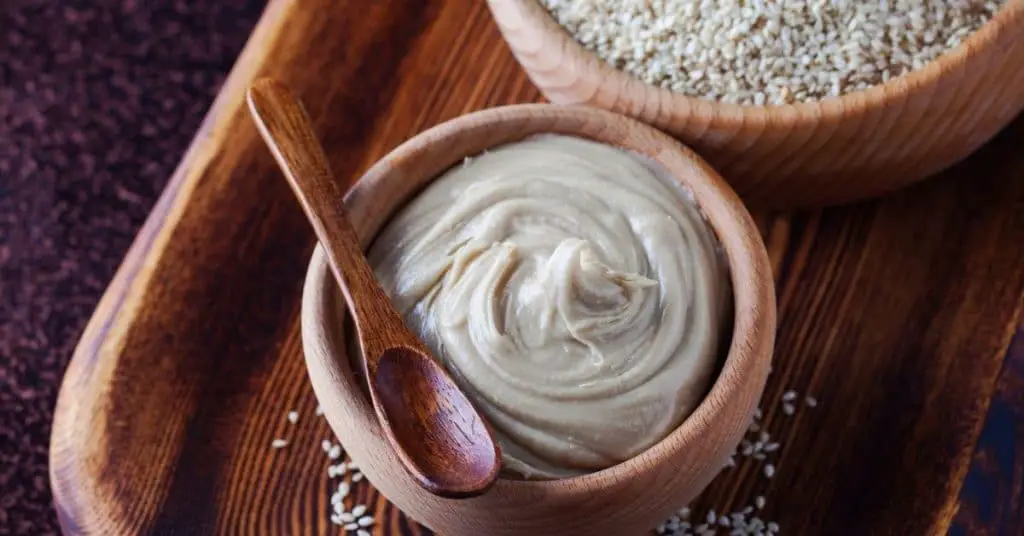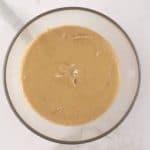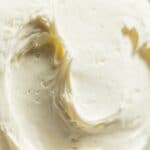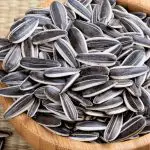In short, there are 6 tahini substitutes you can use: homemade tahini made from sesame seeds and neutral oil, sunflower seed butter, black sesame paste, cashew or almond butter, peanut butter blended with sesame oil, and Greek yogurt. Each option offers a unique flavor and texture that can work well in different recipes.
Traditionally a Middle Eastern and Mediterranean product, tahini is used in sweet and savory recipes. It is added for its unique nutty flavor, dense creamy texture, or both.
Regardless of the purpose tahini serves in your recipe, we’ve got a list of great substitutes if you can’t find it in-store or have run out.
Choose the best substitute for tahini sauce to meet your recipe requirements according to the sweetness, saltiness, texture, and density.
What Is Tahini?
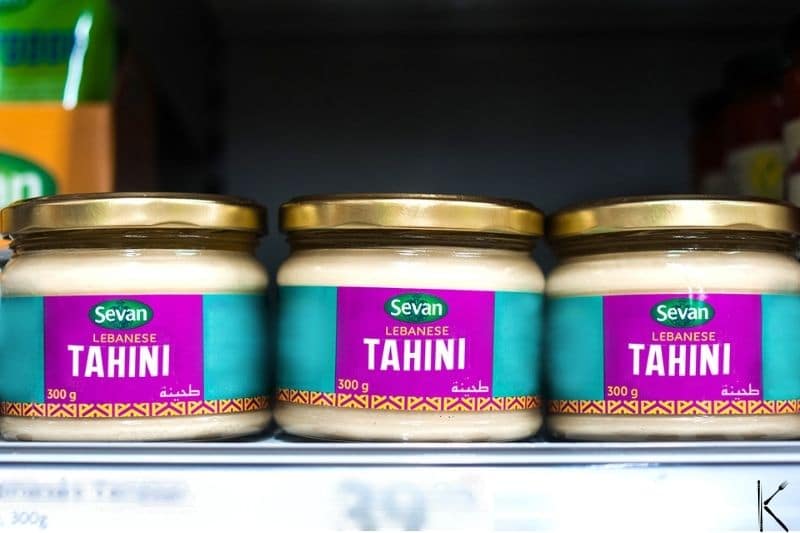
Tahini is a thick and creamy paste made from toasted sesame seeds that are ground to a smooth paste with a creamy consistency. It has a nutty flavor with a slight sweetness and a touch of bitterness.
It is used to make halva (also called halwa), a Middle Eastern sweet confection and more popularly known for its addition to hummus.
Tahini is also used in savory sauces, dips, salad dressings, soups, stews, curry, and as a spread. In sweet items, it is mixed into ice creams or smoothies, and baked into cookies, brownies, and cakes.
Read more on tahini’s shelf life and how to tell if it’s spoiled.
Hulled vs Unhulled Tahini
Hulled tahini refers to tahini made from sesame seeds that have had their outer skin removed. Unhulled tahini still has the bran or hull intact when processing the paste, which results in a browner paste with a slightly more bitter flavor. Hulled tahini is void of the extra fiber with a cleaner nuttier taste.
Best Tahini Substitutes
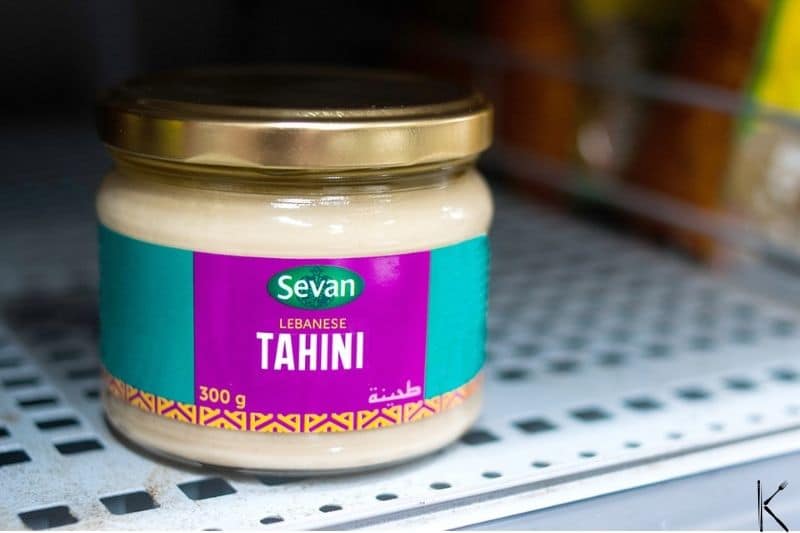
1. Homemade Tahini
If you can’t find tahini in-store or have run out but have sesame seeds on hand, you can easily whip up your own homemade batch. All you will need are sesame seeds and a neutral flavor oil.
Sesame oil can be used in savory recipes, however, if you are going to use the tahini in a few different applications, stick to canola oil which allows more versatility.
Toast the sesame seeds just lightly on the stovetop until golden and fragrant. Don’t leave them for too long without keeping an eye on them as they can go from raw to burnt fairly quickly.
Once toasted to your liking, transfer the seeds to a food processor and blend with a few drops of oil to form a smooth paste. The paste should be thick and smooth, yet thin enough to pour.
Best for: Tahini paste made with a neutral oil can be replaced in any recipe where tahini is needed; sweet or savory. If you have used sesame oil, use the tahini paste in savory dishes where the flavors will complement each other.
Substitute quantity: Replace the tahini measure for measure.
2. Sunflower Seed Butter
Sunflower butter makes a good alternative in most dishes. If you have sunflower seeds on hand you can also make your own sunflower seed butter. Lightly toast the hulled sunflower seeds and place them in a blender.
To add some of the sesame flavor, you can add a few drops of sesame oil, however, keep in mind that sesame oil can be overpowering. Alternatively, use a neutral flavor oil like canola. Blend until it forms a smooth yet pourable paste and add salt to taste if you used unsalted seeds.
Best for: Salad dressings, stews, sauces, dips, brownies, halva, cookies, and baked items.
Substitute quantity: Replace the tahini measure for measure with sunflower seed butter.
3. Black Sesame Paste
Black sesame paste is a Japanese condiment also known as Kuro Neri Goma. It is used in sweet and savory dishes. Black sesame paste is made with 100% black sesame seeds in the same way regular tahini is made.
The taste is rich and slightly nuttier than white tahini. Due to the dark color of this paste, it may ruin the appeal of many dishes, so it is not advisable to add it to hummus, dips, or sauces since they will likely turn an odd grey or unpleasant brown color.
Best for: Baked items such as chocolate brownies, chocolate cake, and cookies.
Substitute quantity: Replace the tahini measure for measure.
4. Cashew and Almond Butter
You can use any type of nut butter whether it be cashew butter, almond, or macadamia butter as a tahini substitute. The flavor profile won’t be exactly the same, but you will achieve the same rich creamy texture.
Nut butters tend to be quite expensive which can make this a pricey alternative, however, if you have some on hand it will save you a trip to the grocery store.
If you don’t have nut butter, but you do have the nuts, you can make your own nut butter by blending the nuts at high speed in a blender. Scrape the sides occasionally to make sure all the nut pieces are blended into a fine paste.
Best for: Most recipes where tahini is called for including baking, stews, curries, and sauces.
Substitute quantity: Substitute measure for measure.
5. Peanut Butter
Peanut butter is one of the easiest ingredients to substitute tahini since you probably have it in your pantry already (unless you have an allergy).
Peanut butter has a strong flavor and is a little denser than tahini. It will add a different taste dimension to your dish, but most peanut butter lovers don’t mind that, especially in baked goods. To incorporate a little of the sesame flavor, add a few drops of sesame oil.
Best for: Plain peanut butter is best used in baked items such as cookies, brownies, and cakes. Blended with sesame oil, it can be used in some savory cooking and sauce recipes.
Replacement quantity: Blend three parts peanut butter with one part sesame oil. Use only half of the amount of tahini required in your recipe. If your recipe calls for 4 tablespoons of tahini, use only 2 tablespoons of the peanut-sesame mixture.
6. Greek Yogurt
Greek yogurt won’t be an exact match for tahini, but it can be a creamy lower calorie alternative. Although Greek yogurt is thick and creamy, it doesn’t have the same palette-clinging density. It also has a tangy flavor unlike tahini and lacks the nuttiness.
Although fantastic as a fresh ingredient, be careful when using Greek yogurt in cooked dishes as it might curdle when heated at high temperatures.
When adding the yogurt to any cooking such as curries, soups, or sauces, add it at the end of the cooking time to retain its smooth and creamy integrity.
Best for: Greek yogurt makes a good substitute in dips and dressings.
Replacement quantity: Substitute in equal measures.
FAQs
Conclusion
Whether drizzled over falafel, used in a dip or to create sweet treats, tahini will add a delicious nutty flavor and deep creamy texture to your dish.
If your tahini substitute doesn’t have the same hint of sesame flavor, add a few drops of sesame oil to savory dishes to achieve a closer taste similarity.
There are a variety of easy tahini substitutes to choose from, no matter what type of recipe you are making. If you don’t already have one of the alternatives in your pantry, you can even make tahini or a suitable tahini substitute yourself.
*image by matka_Wariatka/depositphotos
